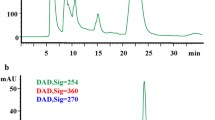Abstract
Quercetin and Rutin are most common flavone constituents of some herb extracts such as Hippophae rhamnoides L. Inter and intra herb pharmacokinetics interactions of Quercetin and Rutin were investigated in the present study. Pharmacokinetic study was investigated in the two groups of rats (n = 6) for pharmacokinetic interactions between the Quercetin and Rutin (2.5 mg/kg) mixture treated alone with European patented polyherbal formulation containing equivalent weight of the above. The total plasma concentrations of Quercetin and Rutin were determined by liquid chromatography mass spectrometry (LC–MS). A method was developed and validated according to the ICH guidelines. The results of the present study shows that there are great differences in the pharmacokinetics of Quercetin and Rutin when they are administered together and from the polyherbal formulation which will be interacted by many other constituents. The bioavailability of Quercetin was lowered from the polyherbal formulation when compared with the co-administration, whereas the Rutin bioavailability has increased from the polyherbal formulation when compared with the co-administration. The maximum plasma concentration of Quercetin from coadministration and polyherbal formulation was 165.3 ± 31.9 and 90.8 ± 21.4 ng/mL, respectively, whereas in the case of Rutin it was 61.1 ± 29.3 and 121.7 ± 19.2 ng/mL. After polyherbal formulation administration to rats the AUC0–24, AUC0–∞ and AUMC0–∞ of both Quercetin and Rutin significantly increased when compared to co-administration. The above results proved that inter and intra herb pharmacokinetic interactions between Quercetin and Rutin. Possible interactions of the other constituents with hydrolyzing enzymes in the formulation enhances the oral bioavailability of Rutin. Accordingly besides the drug herb interactions, inter and intra herb interaction might be brought into view with the wide use of herbal remedies.
Graphical Abstract






Similar content being viewed by others
References
Manach C et al (1995) Quercetin metabolites in plasma of rats fed diets containing rutin or quercetin. J Nutr 125(7):1911–1922
Ilango K et al (2013) Emerging need of pharmacokinetics in Ayurvedic system of medicine. Int J Res Ayurveda Pharm 4(5):1–5
Aruna D, Naidu M (2007) Pharmacodynamic interaction studies of Gingiko biloba with cilostazol and clopidogrel in healthy human subjects. Br J Clin Pharmacol 63:333–338
Brazier N, Levine M (2003) Drug-herb interaction among commonly used conventional medicines: a compendium for health care professionals. Am J Ther 10:163–169
Dubey GP (2005) Herbal preparation for management of cardiovascular and neurologic disorders. European Union, Patent No. EP 1 569 666 B1
Erlund I et al (2000) Pharmacokinetics of quercetin from quercetin aglycone and rutin in healthy volunteers. Eur J Pharmacol 56:545–553
Formica J, Regelson W (1995) Review of the biology of Quercetin and related bioflavanoids. Food Chem Toxicol 33:1061–1080
Graefe E et al (2001) Pharmacokinetics and bioavailability of quercetin glycosides in humans. J Clin Pharmacol 41:492–499
Guowen L et al (2012) Pharmacokinetic properties of isorhamnetin, kaempferol and quercetin after oral gavage of total flavones of Hipphophae rhamnoides L. in rats using a UPLC-MS method. Fitoterapia 83:182–191
Hollman PC et al (1997) Relative bioavailability of the antioxidant flavanoids quercetin from various foods in man. FEBS Lett 418:152–156
Hollman P et al (1999) The sugar moiety is a major determininant of the absorption of dietary flavanoid glycosides in man. Free Radic Res 31:569–573
International Conference on Harmonization (1996) Guideline on validation of analytical procedure-methodology. IFPMA, Geneva
Ke L et al (2008) Intra-herb pharacokinetics interaction between quercetina nd isorhamentin. Acta Pharmacologica Sinica 29(11):1376–1382
Lan K, Jiang X, He J (2007) Quantitative determiniation of isorhamnetin, quercetin and kaempferol in rat plasma by liquid chromatography with electron spray ionization tandem mass spectrometry and its application to the pharmacokinetic study of isorhamnetin. Rapid Commun Mass Spectrom 21:112–120
Shargel L, Susanna W-P, Andrew B (2012) Applied biopharmaceutics and pharmacokientics, 5th edn. McGraw-Hill, New York
Vinson JA, Jang J, Dabbagh YA, Serry MM, Cai S (1995) Plant polyphenols exhibit lipoprotein-bond antioxidant activity using an in vitro oxidation model for heart disease. J Agric Food Chem 43:2798–2799
Yang J et al (2012) Identificaiton of rutin deglycosylated metabolites produced by human intestinal bacteria using UPLC-Q TOF/MS. J Chromatogr B 898(1):95–100
Acknowledgments
The authors would like to thank the Department of Science and Technology, Government of India, for providing financial assistance to carry the work and Department of Pharmacology, SRM College of Pharmacy, SRM University, for providing facilities to carryout animal studies.
Conflict of Interest
The authors declare no conflict of interest.
Author information
Authors and Affiliations
Corresponding author
Rights and permissions
About this article
Cite this article
Kammalla, A.K., Ramasamy, M.K., Chintala, J. et al. Comparative pharmacokinetic interactions of Quercetin and Rutin in rats after oral administration of European patented formulation containing Hipphophae rhamnoides and Co-administration of Quercetin and Rutin. Eur J Drug Metab Pharmacokinet 40, 277–284 (2015). https://doi.org/10.1007/s13318-014-0206-9
Received:
Accepted:
Published:
Issue Date:
DOI: https://doi.org/10.1007/s13318-014-0206-9




